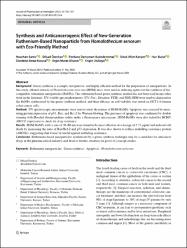Synthesis and Anticancerogenic Effect of New Generation Ruthenium-Based Nanoparticle from Homalothecium sericeum with Eco-Friendly Method

Göster/
Erişim
info:eu-repo/semantics/openAccessTarih
2023Yazar
Samir, NourhanOzerkan, Dilsad
Danisman-Kalindemirtas, Ferdane
Kariper, Ishak Afsin
Bulut, Huri
Kuruca, Düerdane Serap
Altuner, Ergin Murat
Ulukaya, Engin
Üst veri
Tüm öğe kaydını gösterKünye
Samir, N., Özerkan, D., Danışman-Kalındemirtaş, F., KARİPER, İ. A., Bulut, H., Kuruca, D. S., ... Altuner, E. M.(2023). Synthesis and Anticancerogenic Effect of New Generation Ruthenium-Based Nanoparticle from Homalothecium sericeum with Eco-Friendly Method. Journal of Pharmaceutical Innovation , vol.18, no.2, 756-767.Özet
BackgroundGreen synthesis is a simple, inexpensive, and highly efficient method for the preparation of nanoparticles. In this study, ethanol extracts of Homalothecium sericeum (HOM) moss were used as reducing agents for the synthesis of biocompatible ruthenium nanoparticles (RuNPs). The ruthenium-based green synthesis method has not been used in any other work in the literature. UV-visible spectrophotometer (UV-Vis), Zetasizer, FTIR, and EDX-SEM were used to characterize the RuNPs synthesized by the green synthesis method, and their efficacy on cell viability was tested on HCT116 human colon cancer cells.MethodsUV spectroscopic measurements were used to study the release of HOM-RuNPs. Apoptosis was assessed by measuring protein expression of p53, Bax, and Bcl-2 by Western blotting. The presence of apoptosis was confirmed by double staining with Hoechst dye/propidium iodide under a fluorescence microscope. HOM-RuNPs were also tested for BCRP/ABCG2 expression to check for drug resistance.ResultsHOM-RuNPs with a size of 70-80 nm were found to be most effective at a dosage of 5.71 mu g/ml and induced cell death by increasing the ratio of Bax/Bcl-2 and p53 expression. It was also shown to reduce multidrug resistance protein (ABCG2), suggesting that it may be useful against multidrug resistance.ConclusionRuthenium-based nanoparticles synthesized by a green synthesis technique may be a candidate for anticancer drugs in the pharmaceutical industry and deserve further attention for proof-of-concept studies.
















